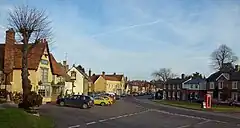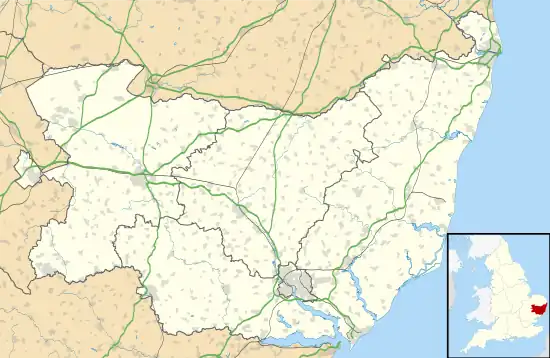| Cavendish | |
|---|---|
 Cavendish High Street, seen from the green | |
 Cavendish Location within Suffolk | |
| Population | 1,026 (2011)[1] |
| OS grid reference | TL805464 |
| District | |
| Shire county | |
| Region | |
| Country | England |
| Sovereign state | United Kingdom |
| Post town | SUDBURY |
| Postcode district | CO10 |
| Dialling code | 01787 |
| Police | Suffolk |
| Fire | Suffolk |
| Ambulance | East of England |
| UK Parliament | |
Cavendish is a village and civil parish in the Stour Valley in Suffolk, England.
Toponymy
Toponymists agree that Cavendish is called so because a man called Cafa once owned an eddish (pasture for aftermath)[2] here.[3] Keith Briggs and Kelly Kilpatrick provide a number of different spellings following the Doomsday Book before it became settled as Cavendish. They also say Cafan is the genitive suffix meaning 'of'.[4]: 31
History

It was home to Sir John Cavendish, the ancestor of the Dukes of Devonshire, who was involved in suppressing the Peasants' Revolt. Wat Tyler, the peasants' leader, was arrested by William Walworth, the Mayor of London, for threatening King Richard II in 1381. As Tyler fought back, Cavendish's son, also called John, who was responsible for escorting the King, ran Tyler through with his sword, killing him.[5] As a result, John Cavendish tried to flee from the pursuing peasants, and he hung on to the handle of the door of St Mary's Church to plead sanctuary.[6] A few days later, on 15 June 1381, the elder John Cavendish was seized at Bury St Edmunds and beheaded by a mob led by Jack Straw.[7] He is buried in Bury St Edmunds. St Mary's Church had a bequest from Sir John, and its chancel was restored.
The village has a United Reformed Church, where Catholic services are also held, and three pubs - the Five Bells, the George, and the Bull. Leonard Lord Cheshire and his wife Sue Ryder are buried in Cavendish Cemetery and there is a memorial to them within St Mary's Church. The museum at Cavendish is now closed but history of the Sue Ryder Foundation and life at the Cavendish home may be obtained from the Sue Ryder legacy and history team. As Cavendish was begun as a home for concentration camp survivors the charity holds some records of the people who were rescued by Sue Ryder.[8]
Other notable people
- George Cavendish (1497 – c. 1562) an English writer, known as the biographer of Cardinal Thomas Wolsey.[9]
- Sir William Cavendish MP (ca.1505 – 1557) a politician, knight and courtier.[10]
Events
Village events are regularly held on the village green. Cavendish holds an annual summer fete, which is held in September, as well as a smaller fete, which is organised earlier in the year by the local church, along with an annual fireworks event.
References
- ↑ "Civil Parish population 2011". Neighbourhood Statistics. Office for National Statistics. Retrieved 18 August 2016.
- ↑ "eddish". Wordnik.com. Wordnik. Retrieved 16 May 2023.
- ↑ Skeat, Rev'd Walter (1913). The Place-Names of Suffolk. The Cambridge Antiquarian Society.
- ↑ Briggs, Keith; Kilpatrick, Kelly (2016). A dictionary of Suffolk place-names. Nottingham: English Place-Name Society. ISBN 978-0-904889-91-8.
- ↑ Notices of the Manor of Cavendish, in Suffolk, and of the Cavendish Family while possessed of that Manor. By Thomas Ruggles, Esq. F. A. S. Read May 3, 1792. in Archaeologia, or, Miscellaneous tracts relating to antiquity, Volume XI
- ↑ "C is for Cavendish". BBC Suffolk online. Retrieved 16 January 2008.
- ↑ Family History Monthly, No.24, September 1997, "Cavendish: The Dukes of Devonshire", Brenda Lewis
- ↑ "Sue Ryder". Sue Ryder. Retrieved 13 April 2023.
- ↑ Gosse, Edmund William (1911). . Encyclopædia Britannica. Vol. 5 (11th ed.). pp. 579–580.
- ↑ . Encyclopædia Britannica. Vol. 5 (11th ed.). 1911. pp. 581–582.